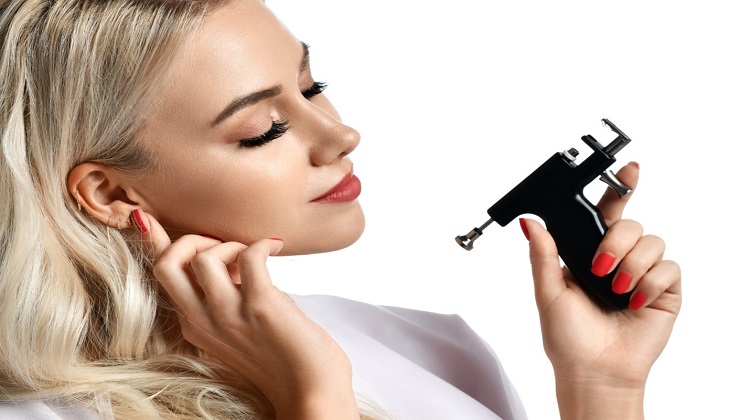Piercings are a way of life for Americans.
Over 83 percent of Americans have their ears pierced, while 14 percent have body piercings. Making the decision to get a piercing isn’t easy. This is especially true if you’re getting a higher-risk piercing or opting to pierce your child’s ears.
One thing is for sure, if you’re getting a piercing, then it’s critical that you follow the steps necessary for proper piercing care. Not sure what those steps look like? Read on to learn everything you need to know about piercing aftercare!
-
Taking Care of Ear Piercings
Ear piercings are by far the most common form of piercings.
You can get ear piercings from jewelry stores with a piercing gun or from a professional piercer. Professional piercers usually operate out of tattoo and piercing shops, and they have a high level of training. This makes professional piercers an excellent choice for getting your ears pierced.
No matter who pierces your ears, you will be sent home with piercing aftercare instructions. The number one rule when it comes to caring for your new ear piercing is that you should always wash your hands before handling it. Remember, it’s an open wound and you don’t want to risk it getting infected.
Your piercer likely recommended a specific cleaning solution to use. There are many saline cleansing solutions on the market, though. When in doubt, go with your piercer’s recommendation and use it twice a day.
Finally, do not take your earrings out, even for small amounts of time, for the first 6-8 weeks after the piercing. After that, you can take out your earrings for short periods of time, but remember to put them back in. Continue doing this for about a year, at which time your piercing is fully healed.
-
Sleeping Tips
In addition to what you do during the day, you need to take special care at night to keep your ear piercings safe and clean. First, consider sleeping with your hair up and away from your ears at night. Hair harbors dirt and bacteria, and it could lead to infection if it gets too close to your newly-pierced ears.
Similarly, make sure you sleep with a clean pillowcase every night while your ears heal. If you don’t have enough pillowcases to do that, consider using clean towels or t-shirts on your pillow for the first couple of months.
-
Taking Care of Cartilage Piercings
Cartilage piercings are one of the most common forms of piercing outside of an ear lobe piercing. The most common places for cartilage piercings include the stiff parts of the upper ear and sometimes the nose. Cartilage piercings take longer to heal than standard ear piercings, and they also need more vigilant aftercare.
Be sure to follow the instructions your professional piercer gave you in order for your piercing to heal best. In general, it’s important to clean your cartilage piercing with antiseptic soap and warm water twice a day. In addition, soak it in a warm saline solution several times per day.
Just like with standard ear piercings, wash your hands before cleaning or soaking your piercing. Avoid touching the jewelry unless you’re planning on cleaning or soaking it.
Expect your cartilage piercing to take up to 12 months to fully heal. Don’t be fooled! Cartilage piercings heal from the outside to the inside, so they may look healed early on, but still need more time.
-
Taking Care of Oral Piercings
Oral piercings come in a variety of forms. They include piercings of the tongue, lip, uvula, frenum, and cheek.
Oral piercings come with a higher level of risk of infection than ear piercings because of the bacteria present in your mouth. In some instances, infection includes swelling of the tongue, which can make it hard to breathe. The good news is that healing only takes about 3-4 weeks.
Be sure to rinse your piercing with warm salt water after you eat, including after snacks. Don’t kiss anyone during the healing process, and avoid sharing eating and drinking utensils. Avoid food that is overly hot or spicy.
-
Taking Care of Body Piercings
Body piercings are super popular throughout the country. They include navel, nipple, and genital piercings, among others. The risk of infection varies depending on the location of the piercing.
Always wash your hands before handling your new piercing. Clean it using a saline solution as many times as needed during the healing process. You can also soak gauze in saline solution and apply it to your piercing.
Avoid wearing restrictive clothing over your body piercing. Opt for showers over baths to avoid exposing your piercing to bacteria. Finally, restrict all oral contact with the piercing until it is fully healed.
-
Children’s Ear Piercing Care
It’s easy enough to care for your piercing as an adult, but introducing your child to kids earrings is a bit more challenging. The same practices apply for cleaning a child’s ear piercing as they do for adult ear piercings. Make sure to handle the piercing with clean hands and wash and rinse the piercing regularly.
Talk to your child about not touching their ears while the piercing is healing. Many doctors suggest that parents wait until their child is at least 8 years old before getting their ears pierced to help make the healing process as smooth as possible.
Follow These Piercing Aftercare Tips for Success!
Getting a piercing is an exciting, and sometimes expensive endeavor. It also comes with a number of risks, depending on the location of the piercing. For these reasons, it’s critical that you follow through on all of the piercing care steps.
In addition to the piercing aftercare tips we’ve given you here, your piercer should give you a care sheet to help you take care of your new piercing. If something seems off, don’t hesitate to contact your piercer to get more information. The better care you take of your piercing in the healing process, the better your piercing will turn out!
Are you interested in learning more about everything from health and fitness to career and business? You’ve come to the right place. Be sure to explore the rest of our blog for tons of great information!



